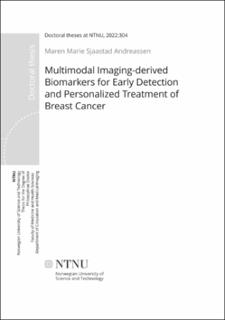| dc.contributor.advisor | Jerome, Neil Peter | |
| dc.contributor.advisor | Bathen, Tone Frost | |
| dc.contributor.author | Andreassen, Maren Marie Sjaastad | |
| dc.date.accessioned | 2024-02-05T07:59:21Z | |
| dc.date.available | 2024-02-05T07:59:21Z | |
| dc.date.issued | 2022 | |
| dc.identifier.isbn | 978-82-326-5933-3 | |
| dc.identifier.issn | 2703-8084 | |
| dc.identifier.uri | https://hdl.handle.net/11250/3115422 | |
| dc.description.abstract | Accurate segmentation of cancer from surrounding healthy breast tissues in magnetic resonance imaging (MRI) without intravenous administration of contrast agents, is a question of wide interest. Current standard-of-care dynamic contrast-enhanced MRI (DCE) depends on Gadolinium contrast. Diffusion-weighted MRI (DWI) avoids the use of contrast since it is able to report on tissue microstructure by detecting diffusion of water molecules and has shown large potential in several breast cancer settings, including assessment of treatment response.
However, the current application of DWI for quantitative studies requires radiologists to manually define tumors based on DCE, prior to transferring the defined regions of interest (ROIs) to the DWI image space for analysis.
In this thesis, we investigated alternative methods to DCE for breast tumor definition and neoadjuvant treatment response evaluation: simultaneous positron emission tomography and MRI (PET/MRI), and optimizing an advanced DWI model, Restriction Spectrum Imaging (RSI), for use in the breast. Since meaningful assessment by the RSI model requires knowledge about the underlying breast diffusion properties, we investigated the optimal fitting of diffusion signal for all voxels in cancer and healthy breast tissues. Furthermore, the optimized RSI model was applied for neoadjuvant treatment response evaluation.
We found that tumor definition using our novel semi-automatic PET/MRI segmentation method, GMM-PET, mimics results normally attained through DCE by successfully tracking the same changes in functional parameters for assessment of neoadjuvant treatment. Secondly, optimal fitting of diffusion signal for all voxels in cancer and healthy breast tissues resulted in a three-component RSI model, with globally-determined component-specific apparent diffusion coefficients (ADCs) that decomposed the diffusion signal to correspond to major anatomical components in healthy breast tissues. These results were then applied for optimized discrimination of cancer from healthy breast tissues directly on DWI images, which yielded the derived RSI parameter, C1C2 that showed highly promising discriminatory performance superior to conventional DWI estimates. The three-component RSI model was further used to develop an automatic tissue classifier (RSI classifier) that was able to assess treatment response after only 3 weeks of neoadjuvant treatment and was found to have similar accuracy to DCE in assessing residual tumor post-therapy.
Our novel methodologies, GMM-PET and three-component RSI model-derived C1C2 parameter, can detect breast cancer without the use of Gadolinium contrast. Of particular interest, the highly promising diagnostic performance of C1C2 was determined using data acquired across different sites, scanners, and imaging acquisition protocols. This suggests a readily available clinical utility that may reduce the need to pre-identify lesions on nondiffusion modalities altogether. The finding that the automatic RSI classifier can assess early response to neoadjuvant treatment is important for improved clinical decision-making to enable tailored treatment regimens. | en_US |
| dc.language.iso | eng | en_US |
| dc.publisher | NTNU | en_US |
| dc.relation.ispartofseries | Doctoral theses at NTNU;2022:304 | |
| dc.relation.haspart | Paper 1: Semi-automatic segmentation from!intrinsically-registered 18F-FDG–PET/MRI for!treatment response assessment in!a!breast cancer cohort: comparison to!manual DCE–MRI Magnetic Resonance Materials in Physics, Biology and Medicine (2020) 33:317–328 https://doi.org/10.1007/s10334-019-00778-8
- This is an open-access article distributed under the terms of the Creative Commons Attribution License (CC BY). | en_US |
| dc.relation.haspart | Paper 2: Rodríguez-Soto, Ana E.; Andreassen, Maren Marie Sjaastad; Fang, Lauren K.; Conlin, Christopher C.; Park, Helen H.; Ahn, Grace S.; Bartsch, Hauke; Kuperman, Joshua; Vidic, Igor; Ojeda-Fournier, Haydee; Wallace, Anne M.; Hahn, Michael; Seibert, Tyler M.; Jerome, Neil Peter; Østlie, Agnes; Bathen, Tone Frost; Goa, Pål Erik; Rakow-Penner, Rebecca; Dale, Anders M.. Characterization of the diffusion signal of breast tissues using multi-exponential models. Magnetic Resonance in Medicine 2021 https://doi.org/10.1002/mrm.29090 | en_US |
| dc.relation.haspart | Paper 3: Andreassen, Maren Marie Sjaastad; Rodriguez-Soto, Ana; Conlin, CC; Vidic, Igor; Seibert, TM; Wallace, AM; Zare, S; Kuperman, J; Abudu, B; Ahn, GS; Hahn, M; Jerome, Neil Peter; Østlie, Agnes; Bathen, Tone Frost; Ojeda-Fournier, H; Goa, Pål Erik; Rakow-Penner, Rebecca; Dale, AM. Discrimination of Breast Cancer from Healthy Breast Tissue Using a Three-component Diffusion-weighted MRI Model. Clinical Cancer Research 2020 ;Volum 27. s. 1094-1104 https://doi.org/10.1158/1078-0432.CCR-20-2017 | en_US |
| dc.relation.haspart | Paper 4: Andreassen, Maren Marie Sjaastad; Loubrie, Stephane; Tong, Michelle W.; Fang, Lauren; Seibert, Tyler; Wallace, Anne M.; Zare, Somaye; Ojeda-Fournier, Haydee; Kuperman, Joshua; Hahn, Michael; Jerome, Neil Peter; Bathen, Tone Frost; Rodríguez-Soto, Ana E.; Dale, Anders; Rakow-Penner, Rebecca. Restriction spectrum imaging with elastic image registration for automated evaluation of response to neoadjuvant therapy in breast cancer. Frontiers in Oncology 2023 ;Volum 13. https://doi.org/10.3389/fonc.2023.1237720
- This is an open-access article distributed under the terms of the Creative Commons Attribution License (CC BY). | en_US |
| dc.title | Multimodal Imaging-derived Biomarkers for Early Detection and Personalized Treatment of Breast Cancer | en_US |
| dc.type | Doctoral thesis | en_US |
| dc.subject.nsi | VDP::Medical disciplines: 700 | en_US |

